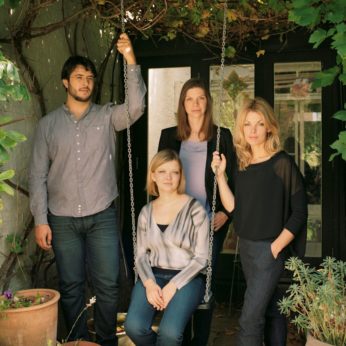Composer: Franz Schubert (b. 1797 - d. 1828)
Performance date: 08/07/2016
Venue: St. Brendan’s Church
Composition Year: 1815
Duration: 00:24:21
Recording Engineer: Richard McCullough, RTÉ lyric fm
Instrumentation: 2vn, va, vc
Instrumentation Category:String Quartet
Artists:
Chiaroscuro Quartet (Alina Ibragimova, Pablo Hernán Benedí [violins], Emilie Hörnlund [viola], Claire Thirion [cello]) -
[quartet]

Schubert was eight years old when his father started
to give him violin lessons. Not long afterwards the Schubert family formed its
own string quartet; Franz with his father and two brothers. The family played a
variety of works from the classical period. They also combined playing concerts
with social occasions. Thus began Schubert’s introduction not only to the great works of classical music but also
into the convivial mixture of music making and partying which he would maintain throughout his life.
As a boy, Schubert had impressed Salieri; one of
the best known composers in
and friend and rival of Mozart’s. Salieri recommended Schubert for the Court
Chapel Choir and for a scholarship at the Imperial and Royal Seminary. There naturally
enough, Schubert played in the school orchestra. He started in the second
violins but soon became the orchestra’s leader. His two favourite orchestral
works were Mozart’s 40th symphony and Beethoven’s Second.
In 1815 he composed over 160 songs, one and a half
symphonies, nine religious orchestral works including the Mass in G major, four
short operas, nine piano pieces and the string quartet in G minor. It has been
calculated that this level of output over the year involved composing 420 bars per
week every week of which about half were orchestral music. The G minor string
quartet consists of about 800 of those bars
It is well known that Mozart and Haydn used each
other’s quartets as models for their own work and Beethoven used both Haydn’s
and Mozart’s quartets as reference points for his early quartets. It is not
surprising that Schubert did the same. The G minor quartet bears strong
similarities in a few places to parts of Beethoven’s Op.18/2 and 18/4 although
it takes a sharp ear to spot them.
The more obvious reference in this G minor quartet
is to Schubert’s favourite G minor symphony; Mozart’s 40th. The
opening theme of the first movement bears a strong resemblance to the opening
theme of the last movement of the Mozart symphony. After the opening theme has been repeated
there is some obvious transitional material before the appearance of the
charming and contrasting second subject. The whole movement has great drive and
a wonderful variety of material.
The Andantino
is based on a very simple three note phrase. The second note always repeats the
first. The third note, which bears the emphasis, is, initially, a third or an
octave higher. The three note phrase is played twice. The relationship between
the repetition and the original statement varies throughout the movement. Out
of this slender material Schubert weaves a delightful fabric.
The minuet has an upright, angular tune while the
trio adds charm with the first and second violins answering each other with
repeated phrases. The quartet concludes with a cheerful rondo with sonata form
features; each episode providing opportunities for both development and counterpoint.
Copyright © 2025 West Cork Music. All rights reserved.
Designed and developed by Matrix Internet